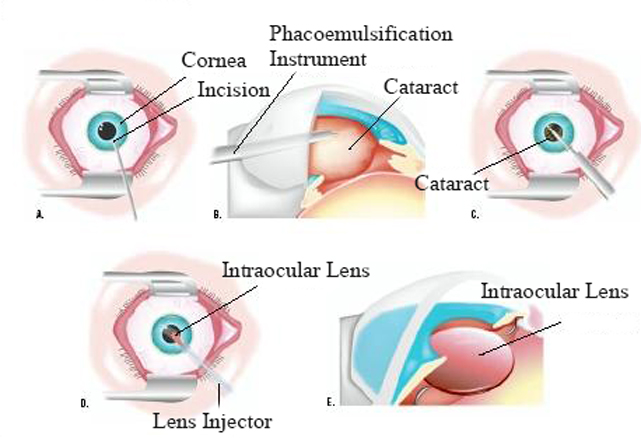Cataract is a disease of the lens of the eye, leading to loss of vision, first partial and then complete. The eye lens becomes cloudy, and a person sees the world through a veil. Most often, the disease occurs in the elderly, but there are cases of cataracts in young children.
Cataract Phacoemulsification with IOL implantation is a gentle and effective method in which the affected lens is replaced with an intraocular lens.
As a result of the operation performed without suture (as opposed to cataract extraction through large incisions), vision is completely restored, there is no need to limit yourself later.

Indications for Phacoemulsification surgery:
Ultrasonic cataract Phacoemulsification can be performed at any stage of the disease, without waiting for cataract maturation. Today, this operation is officially recognized as the only one that allows you to fully restore the patient’s vision. The use of the method has no restrictions on the age of patients.
Preparatory stage:
When conducting an examination, you need to accurately answer the doctor’s questions about past diseases, allergies, and the presence of chronic diseases.
• Before cataract Phacoemulsification surgery, the patient must undergo a complete examination and pass tests.
• Any focus of infection must be eliminated, as it can have a negative impact on the course of the postoperative period.
• Be sure to conduct a thorough examination of the ophthalmologist and anesthetist.
Procedure for cataract Phacoemulsification:
Cataract Phacoemulsification with IOL implantation involves the removal of the clouded lens substance using ultrasound and the installation of a flexible lens in its place, which is securely fixed and provides optical function. The patient returns home the same day.
The operation is carried out in stages.
A small incision (microaccess) is made in the cornea, through which all manipulations are carried out.
A special microsurgical device – phacoemulsifier turns the natural lens into an emulsion and removes it outside the eye.
A new, artificial, folded intraocular lens is inserted into the capsule where the lens was previously located. After the introduction, it unfolds and is fixed.
Subsequently, micro-access is eliminated by self-sealing.

Benefits of ultrasonic cataract Phacoemulsification:
• The patient gets rid of the cataract.
• Vision is restored as much as possible, taking into account the state of the structures of the eye.
• The operation is performed without hospitalization, in one day.

• The patient does not require care loss of independence does not occur.
• Vision is restored immediately, and the maximum effect of the operation appears after a few days.
• The rehabilitation period is minimal.
• In the future, no physical or visual restrictions are required.
• Local anesthesia is used, which is well tolerated by patients of any age.
• Ultrasonic phacoemulsification of cataracts can be performed with clouding of the lens at any stage of the development of the disease, including the earliest.
• The IOL models used make it possible to eliminate astigmatism, hyperopia or myopia, if they occurred before the onset of the disease.
Cataract Phacoemulsification cannot be performed if:
• The patient has an exacerbation of chronic diseases; • The patient is in critical condition; • In the area of the eyelids and eyes there is an inflammatory process or there is an oncological disease; • The patient has a mental disorder.
In some cases, Phacoemulsification is not recommended if the patient has other eye diseases, as there is a risk of not getting the desired result. In any case, each specific case requires careful consideration and consultation with an ophthalmologist.
Possible complications after Phacoemulsification:
Surgery will cause some discomfort in the operated area. There may be pain in the eye and adjacent tissues. After the operation, it is necessary to visit the ophthalmologist regularly to prevent possible complications. By following simple rules and using prescribed medications, you can avoid discomfort in the operated area and complications.
Recovery period:
Vision returns immediately after cataract Phacoemulsification. After two hours, the patient goes home and comes for an examination the next day. An examination by a surgeon is carried out and anti-inflammatory drops are prescribed, which are used according to the scheme for up to 1 month. Further recovery is carried out at home. After cataract Phacoemulsification, the patient’s normal rhythm of life does not change. There are no restrictions on visual loads, you can watch TV, read, work on a computer. In this case, you cannot:
- Give large visual loads during the first two weeks;
- Physically influence the operated eye by rubbing or pressing it;
- Lift weights;
- Fall asleep lying on the side of the operated eye;
- Use decorative cosmetics;
- Smoking and drinking alcohol. It is important to stick to a diet, exclude heavy and spicy foods, and use eye drops prescribed by a doctor during the recovery period.
Benefits of choosing AgIstanbulHealth
Only top qualified doctors
JCI certificated hospitals
Free COVID-19 Test before departure
4 nights in a 5-star hotel in Istanbul
Costs for laboratory, medication and equipment
Pre/post-operative tests
Free Istanbul tours
Latest technologies
Excelent travel assistance
All-round VIP transfer
Credit / Debit cards accepted
No prepayment
Personal assistants speak in English
24/7 customer service

